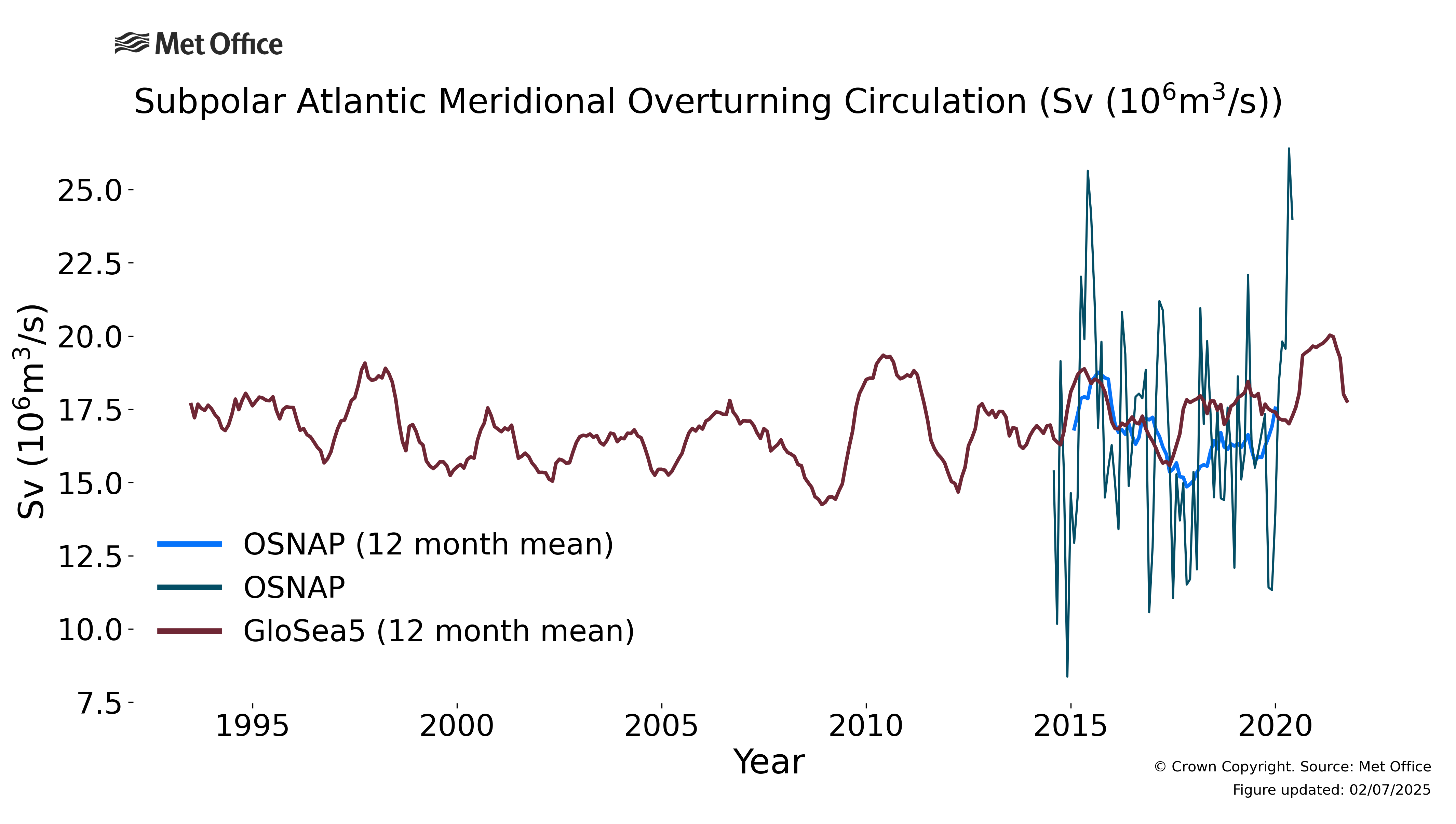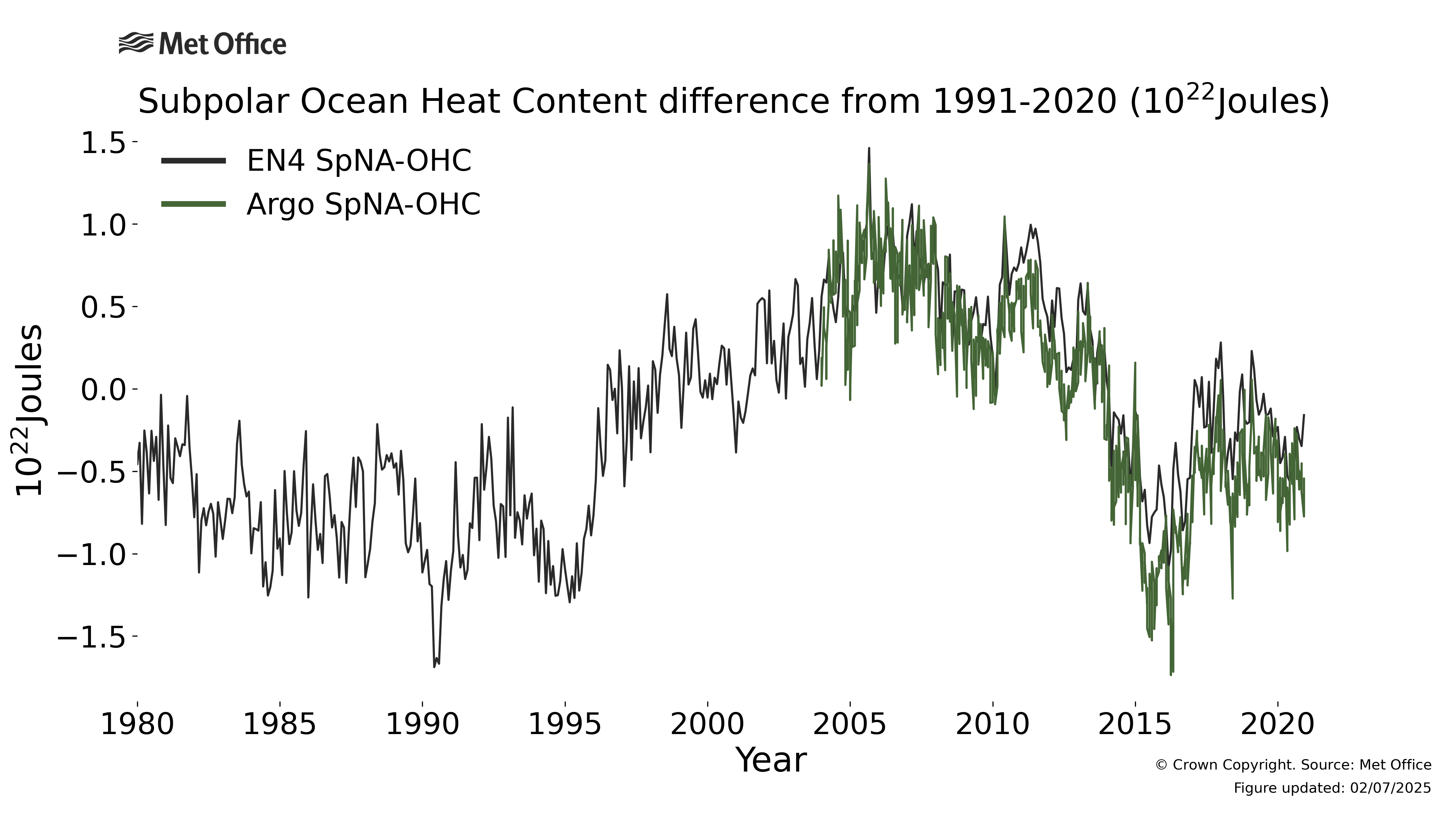Why are the AMOC and SpNA-OHC important?
The Atlantic Meridional Overturning Circulation (AMOC) is a measure of the movement of water in the North Atlantic: warm water is transported northward into the subpolar North Atlantic (high northern latitudes), where it cools and sinks before returning southward in the deep ocean. This northward transport of heat is responsible for the mild climate of Western Europe compared to North-Eastern North America. Changes in the AMOC change the sea temperature in the North Atlantic and hence have a wide range of impacts, including on temperature and precipitation in Europe, sea level along the US East Coast, Atlantic hurricane activity and tropical monsoons. Therefore, monitoring changes in the AMOC is crucial to understand future changes in the climate of these regions.

The AMOC transports heat northwards, and so it can have a significant impact on the subpolar North Atlantic ocean heat content (SpNA-OHC), although this is also affected by the heat transport from wind-driven flow and heat exchanged between the ocean and atmosphere. The SpNA-OHC captures the long-term changes of heat transport into the subpolar regions of the North Atlantic.
The Subpolar North Atlantic Ocean Heat Content (SpNA-OHC) is a measure of the amount of heat stored in the upper 1000m of the ocean in the North Atlantic region (45°-67°N). It measures changes in the heat supply to this region, and is linked to the AMOC and other measures of Atlantic variability.
How have the AMOC and SpNA-OHC changed?
The AMOC has been continually measured across the North Atlantic at two latitudes: the RAPID array is at 26.5°N (in the subtropical North Atlantic), and the OSNAP array at 50-60°N (in the subpolar North Atlantic). However, only relatively short timeseries are available from these two, allowing only multi-annual (and shorter timescale) variability to be determined rather than multi-decadal variability.
There is significant inter-annual variability in the subtropical North Atlantic overturning circulation from the RAPID measurements, with a large decline in 2009/10. Much of this variability is driven by changes in local winds. There was a weakening of the subtropical AMOC from 2004-2014, although a longer timeseries is needed to put this into context. An estimate of the subtropical AMOC from the GloSea5 reanalysis suggests it was stronger in the late 90's, declining around 2000 before increasing to the mid-2000's.
The subpolar AMOC observed across the OSNAP array also has large inter-annual variability and a strong seasonal cycle. Only four years of data are available from the OSNAP array observations. An estimate of the AMOC at the OSNAP array from the GloSea5 reanalysis has had no long-term trend since 1993, although it has significant inter-annual variations. However, changes earlier in the timeseries are more uncertain as subsurface observations are sparse during this period and the trend differs among reanalysis products.
The SpNA-OHC increased through the late 90's and early 2000's, before declining after 2011. Since 2013, the OHC has been below the 1991-2020 average, so the northern North Atlantic is colder than normal.
How are the AMOC and SpNA-OHC measured?
Continuous observations of the AMOC are obtained by deploying basin-wide observing arrays across the Atlantic Ocean that are used to infer the volume flow rate across the array in units of Sverdrups (1Sv = 106 m3 s-1). The arrays measure ocean velocity, pressure, temperature and salinity using various sensors. Full depth moorings are used to estimate the density profiles across the basin, allowing the net transport in the ocean interior to be calculated. Transports of water by surface winds (known as Ekman transports) and transports from boundary currents obtained from velocity measurements are added to obtain the total transport.
A reconstruction of the AMOC strength from the GloSea5 ocean reanalysis is also shown at both latitudes. Ocean reanalyses combine observations with an ocean model based on physical equations and properties to infer past changes in climate. The GloSea5 reanalysis uses observations of ocean temperature, salinity, sea ice concentration and sea level from both in situ and satellite observations.
The SpNA-OHC is the heat content of the upper 1000m of the subpolar North Atlantic (45°-67°N) calculated from temperature observations (using Argo or EN4 datasets) and is presented as the difference from the long-term (1991-2020) average.
Why have the AMOC and SpNA-OHC changed?
The AMOC varies significantly on many timescales. Changes in the strength of the wind has an important impact on monthly and inter-annual variations, while decadal changes are caused by internal variability of the ocean and longer-term climate forcings such as increases in greenhouse gases.
The AMOC weakens in response to increases in atmospheric greenhouse gas concentrations because it leads to warming and freshening (from increased precipitation and the melting of Arctic sea ice and the Greenland ice cap) of the North Atlantic. Detecting human influence on changes of the AMOC is challenging, because it requires long timeseries to distinguish it from internal variability.
Changes in the subpolar North Atlantic OHC (SpNA-OHC) are caused by both changes in the surface heat fluxes and ocean circulation, although it is thought ocean circulation changes dominate on timescales greater than about a decade.
Find out more?
AMOC
RAPID (12 month mean)
- Information reference: Moat B.I.; Smeed D.A.; Rayner D.; Johns W.E.; Smith, R.; Volkov, D.; Elipot S.; Petit T.; Kajtar J.; Baringer M. O.; and Collins, J. (2024). Atlantic meridional overturning circulation observed by the RAPID-MOCHA-WBTS (RAPID-Meridional Overturning Circulation and Heatflux Array-Western Boundary Time Series) array at 26N from 2004 to 2023 (v2023.1), British Oceanographic Data Centre - Natural Environment Research Council, UK.
RAPID
- Information reference: Moat B.I.; Smeed D.A.; Rayner D.; Johns W.E.; Smith, R.; Volkov, D.; Elipot S.; Petit T.; Kajtar J.; Baringer M. O.; and Collins, J. (2024). Atlantic meridional overturning circulation observed by the RAPID-MOCHA-WBTS (RAPID-Meridional Overturning Circulation and Heatflux Array-Western Boundary Time Series) array at 26N from 2004 to 2023 (v2023.1), British Oceanographic Data Centre - Natural Environment Research Council, UK.
GloSea5 (12 month mean)
- Information source: Jackson, L. C., Dubois, C., Forget, G., Haines, K., Harrison, M., Iovino, D., Köhl, A., Mignac, D., Masina, S., Peterson, K. A., Piecuch, C. G., Roberts, C. D., Robson, J., Storto, A., Toyoda, T., Valdivieso, M., Wilson, C., Wang, Y., & Zuo, H. (2019). The Mean State and Variability of the North Atlantic Circulation: A Perspective From Ocean Reanalyses. Journal of Geophysical Research: Oceans, 124(12), 9141–9170.
- Information source: Baker J, Renshaw R, Jackson L, Dubois C, Iovino D, Zuo H. 2022. Overturning variations in the subpolar North Atlantic in an ocean reanalyses ensemble. Copernicus Marine Service Ocean State Report, Issue 6, Journal of Operational Oceanography.
AMOC
OSNAP (12 month mean)
- Information source: Fu, Y., Lozier, M.S., Biló, T.C. et al. Seasonality of the Meridional Overturning Circulation in the subpolar North Atlantic. Commun Earth Environ 4, 181 (2023).
- Information reference: Fu, Yao, Lozier, M. Susan, Biló, Tiago Carrilho, Bower, Amy S., Cunningham, Stuart A., Cyr, Frédéric, de Jong, M. Femke, deYoung, Brad, Drysdale, Lewis, Fraser, Neil, Fried, Nora, Furey, Heather H., Han, Guoqi, Handmann, Patricia, Holliday, N. Penny, Holte, James, Inall, Mark E., Johns, William E., Jones, Sam, Karstensen, Johannes, Li, Feili, Pacini, Astrid, Pickart, Robert S., Rayner, Darren, Straneo, Fiammetta, Yashayaev, Igor, (2023): Meridional Overturning Circulation Observed by the Overturning in the Subpolar North Atlantic Program (OSNAP) Array from August 2014 to June 2020.
OSNAP
- Information source: Fu, Y., Lozier, M.S., Biló, T.C. et al. Seasonality of the Meridional Overturning Circulation in the subpolar North Atlantic. Commun Earth Environ 4, 181 (2023).
- Information reference: Fu, Yao, Lozier, M. Susan, Biló, Tiago Carrilho, Bower, Amy S., Cunningham, Stuart A., Cyr, Frédéric, de Jong, M. Femke, deYoung, Brad, Drysdale, Lewis, Fraser, Neil, Fried, Nora, Furey, Heather H., Han, Guoqi, Handmann, Patricia, Holliday, N. Penny, Holte, James, Inall, Mark E., Johns, William E., Jones, Sam, Karstensen, Johannes, Li, Feili, Pacini, Astrid, Pickart, Robert S., Rayner, Darren, Straneo, Fiammetta, Yashayaev, Igor, (2023): Meridional Overturning Circulation Observed by the Overturning in the Subpolar North Atlantic Program (OSNAP) Array from August 2014 to June 2020.
GloSea5 (12 month mean)
- Information source: Jackson, L. C., Dubois, C., Forget, G., Haines, K., Harrison, M., Iovino, D., Köhl, A., Mignac, D., Masina, S., Peterson, K. A., Piecuch, C. G., Roberts, C. D., Robson, J., Storto, A., Toyoda, T., Valdivieso, M., Wilson, C., Wang, Y., & Zuo, H. (2019). The Mean State and Variability of the North Atlantic Circulation: A Perspective From Ocean Reanalyses. Journal of Geophysical Research: Oceans, 124(12), 9141–9170.
- Information source: Baker J, Renshaw R, Jackson L, Dubois C, Iovino D, Zuo H. 2022. Overturning variations in the subpolar North Atlantic in an ocean reanalyses ensemble. Copernicus Marine Service Ocean State Report, Issue 6, Journal of Operational Oceanography.
OHC
EN4 SpNA-OHC
- Information source: Good, S. A., M. J. Martin and N. A. Rayner, 2013. EN4: quality controlled ocean temperature and salinity profiles and monthly objective analyses with uncertainty estimates, Journal of Geophysical Research: Oceans, 118, 6704-6716
- Information source: Desbruyères, D. G., Purkey, S. G., McDonagh, E. L., Johnson, G. C. & King, B. A. Deep and abyssal ocean warming from 35 years of repeat hydrography. Geophys. Res. Lett. 43, 10.356–10.365 (2016).
- Information reference: Moat B.I.; King B.A.; Macintosh C.R.(2021). Subpolar North Atlantic ocean heat content (surface to 1000m) using the EN4.2.2 temperature data set. NERC EDS British Oceanographic Data Centre NOC. doi:10.5285/d09552c1-5e31-55e1-e053-6c86abc067f3, via the North Atlantic Climate System Integrated Study (ACSIS, http://www.acsis.ac.uk).
Argo SpNA-OHC
- Information source: Argo (2000). Argo float data and metadata from Global Data Assembly Centre (Argo GDAC). SEANOE
- Information source: Desbruyères, D. G., Purkey, S. G., McDonagh, E. L., Johnson, G. C. & King, B. A. Deep and abyssal ocean warming from 35 years of repeat hydrography. Geophys. Res. Lett. 43, 10.356–10.365 (2016).
- Information reference: Moat B.I.; King B.A.; Macintosh C.R.(2021). Subpolar North Atlantic ocean heat content (surface to 1000m) using objectively mapped Argo profiling float data. NERC EDS British Oceanographic Data Centre NOC. doi:10.5285/d23c26bc-6e6c-5bbf-e053-6c86abc02cfb, via the North Atlantic Climate System Integrated Study (ACSIS, http://www.acsis.ac.uk).


